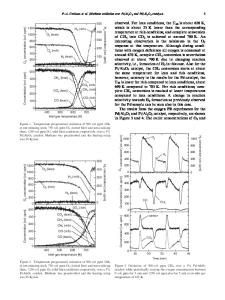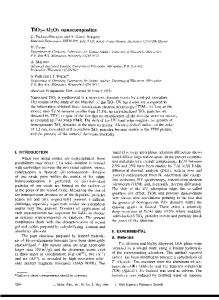Diffusion of oxygen in the Al 2 O 3 oxidation product of TiAl 3
- PDF / 862,579 Bytes
- 6 Pages / 612 x 792 pts (letter) Page_size
- 65 Downloads / 321 Views
I. INTRODUCTION
THE continuing interest in the titanium-based aluminides for high-temperature applications has encouraged fundamental research in the material. The TiAl3, TiAl, and Ti3Al aluminides are of the greatest interest because of their conceivable high-temperature specific strength, specific modulus, and good environmental properties at high temperatures. Alloying with several elements like Nb, Cr, Mn, etc., improves the oxidation resistance of Ti-Al alloys. The most effective oxidation resistance of Ti-A1 alloys is the formation of continuous a-Al2O3 scales via oxidation, because the transport of reactants through a-Al2O3 is slow compared to transport through most other oxides, especially TiO2.[1,2] The growth of alumina scales by oxidation of “alumina-forming alloys” is controlled by grain-boundary or short-circuit diffusion. The lattice structure of corundum (Al2O3) reveals a coordination number of 6 for cations and 4 for anions. Birks et al.[3] proposed that a number of factors affect the development of Al2O3 scales on alloys and that these include the chemical composition, microstructure of the alloy, and the surface condition of the alloys. In the TiAl binary system, only TiAl3 forms a continuous a-Al2O3 over a wide temperature range, due to its high aluminum content.[1,4] The alloy is also reported to exhibit anomalous oxidation rates for short-term exposures at lower temperatures. The anomalous behavior was attributed to the formation of an Al phase. TiAl3 has generally been considered as an oxidationresistant coating. But the material exhibits interdiffusion problems when coated on lower-Al-containing substrates and, thus, leads to scale spallation. Spallation of the protective scale leads to loss of protection. This brittle behavior of the TiAl3 coatings was attributed[5] to mismatches in thermal-expansion coefficients. Many applications of metal oxides are dependent on the atomic and electronic properties of the particular oxide. Considerable information is available in the literature on the R.G. REDDY, ACIPCO Professor, X. WEN, Graduate Student, and I.C.I. OKAFOR, Research Fellow, are with the Department of Metallurgical and Materials Engineering, The University of Alabama, Tuscaloosa, AL 35487-0202. Manuscript submitted January 4, 2000. METALLURGICAL AND MATERIALS TRANSACTIONS A
transport properties of many oxides. But almost all of the data have been developed on single crystals or pure polycrystals of the particular oxide. In this work, we have studied the diffusivity of oxygen in oxidation products of TiAl3, to understand the effect of oxygen mobility in the oxide layer in relation to the oxidescale adhesion. Parabolic-rate data were obtained from thermogravimetric analysis (TGA). The morphology of TiAl3 was also studied after the samples had been oxidized in pure dry oxygen for up to 100 hours at 1273 K. II. MATERIALS AND EXPERIMENTAL PROCEDURES A. Materials and Sample Preparation Titanium wires of 99.9 pct purity and aluminum rods with a reported purity of 99.99 pct were used in this stu











